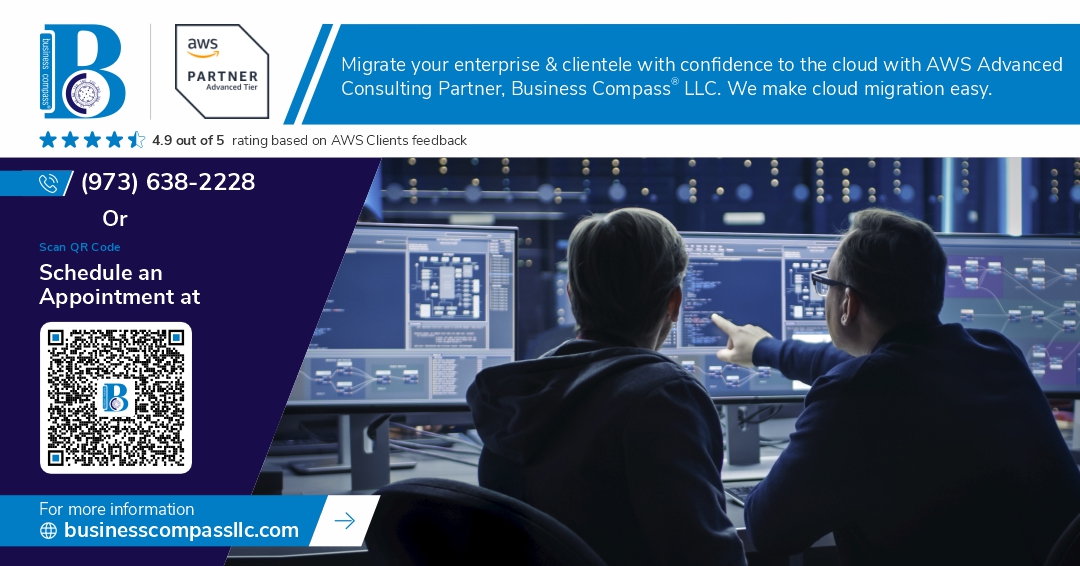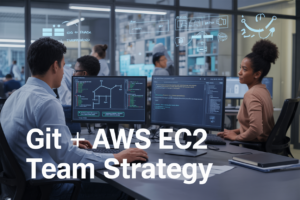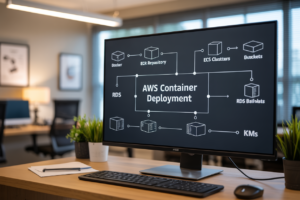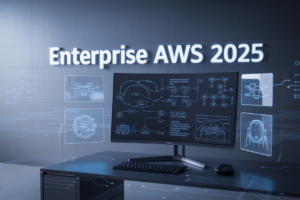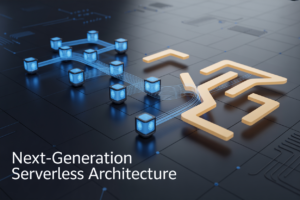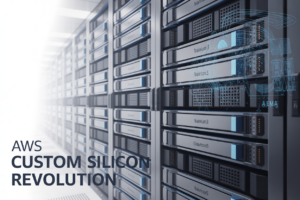Are you drowning in a sea of AWS compute options? 🌊 From the tried-and-true EC2 to the serverless magic of Lambda, the container prowess of Fargate and ECS, to the orchestration power of EKS – the choices can be overwhelming. But fear not, because understanding these services is crucial for optimizing your cloud infrastructure and maximizing your AWS investment.
In this comprehensive guide, we’ll dive deep into the world of AWS compute services, comparing them with other offerings in the AWS ecosystem. We’ll unravel the mysteries of when to use each service, explore their unique advantages, and help you navigate the complex landscape of cloud computing. Whether you’re a seasoned AWS architect or just starting your cloud journey, this post will equip you with the knowledge to make informed decisions about your compute strategy.
Join us as we explore the nuances of EC2, Lambda, Fargate, ECS, and EKS, and discover how they stack up against other AWS services. We’ll cover everything from performance and security to cost optimization and real-world use cases. By the end of this post, you’ll have a clear roadmap for choosing the right compute service for your specific needs. Let’s embark on this exciting journey through the AWS compute landscape! 🚀
Understanding AWS Compute Services
A. EC2: Flexible virtual servers
Amazon Elastic Compute Cloud (EC2) is the cornerstone of AWS compute services, offering scalable and customizable virtual servers. EC2 instances provide:
- Flexible configuration options
- Various instance types for different workloads
- Pay-as-you-go pricing model
| Feature | Description |
|---|---|
| Instance Types | General Purpose, Compute Optimized, Memory Optimized, Storage Optimized |
| Operating Systems | Linux, Windows, macOS |
| Scaling | Auto Scaling groups for dynamic capacity adjustment |
B. Lambda: Serverless functions
AWS Lambda revolutionizes serverless computing by allowing you to run code without provisioning servers. Key benefits include:
- Automatic scaling
- Pay only for compute time used
- Support for multiple programming languages
C. Fargate: Containerized applications
Fargate simplifies container deployment by eliminating the need to manage underlying infrastructure. It offers:
- Seamless integration with ECS and EKS
- Fine-grained resource allocation
- Reduced operational overhead
D. ECS: Container orchestration
Amazon Elastic Container Service (ECS) provides a fully managed container orchestration platform. Features include:
- Native integration with AWS services
- Support for Docker containers
- Task definitions for application components
E. EKS: Managed Kubernetes
Amazon Elastic Kubernetes Service (EKS) offers a managed Kubernetes platform, allowing you to:
- Run Kubernetes without managing the control plane
- Integrate with AWS services
- Leverage the extensive Kubernetes ecosystem
Now that we’ve covered the primary AWS compute services, let’s explore how EC2 compares to other AWS offerings in terms of flexibility, scalability, and use cases.
EC2 vs. Other AWS Services
EC2 vs. S3 for storage
When comparing EC2 and S3 for storage, it’s essential to understand their distinct purposes and capabilities:
| Feature | EC2 | S3 |
|---|---|---|
| Primary Use | Compute instances with attached storage | Object storage service |
| Scalability | Limited by instance type | Virtually unlimited |
| Accessibility | Only through the instance | Directly via HTTP/HTTPS |
| Cost | Charged for running instances | Pay only for storage used |
| Performance | Depends on instance type and EBS volume | Consistent, high throughput |
EC2 is ideal for:
- Running applications that require full server access
- Performing complex computations
- Hosting databases or applications with specific OS requirements
S3 excels in:
- Storing and retrieving large amounts of data
- Serving static website content
- Backup and archiving
EC2 vs. RDS for databases
When deciding between EC2 and RDS for database management:
| Aspect | EC2 | RDS |
|---|---|---|
| Control | Full control over DB and OS | Managed service with less control |
| Maintenance | Manual updates and backups | Automated patching and backups |
| Scalability | Manual scaling | Easy vertical and horizontal scaling |
| Performance | Customizable | Optimized for database workloads |
| Cost | Pay for instance resources | Pay for database usage |
EC2 is suitable for:
- Custom database configurations
- Databases not supported by RDS
- Applications requiring direct OS access
RDS is preferable for:
- Simplified database administration
- Automatic scaling and high availability
- Managed security and compliance
EC2 vs. CloudFront for content delivery
Comparing EC2 and CloudFront for content delivery:
| Feature | EC2 | CloudFront |
|---|---|---|
| Purpose | General-purpose compute | Content Delivery Network (CDN) |
| Global Reach | Limited to instance location | Global edge locations |
| Caching | Manual implementation | Built-in caching mechanisms |
| Security | Custom security measures | Integrated with AWS Shield |
| Scalability | Manual scaling required | Automatic scaling |
EC2 can be used for content delivery when:
- Custom server-side processing is needed
- Serving dynamic content that can’t be cached
- Specific geographic restrictions apply
CloudFront excels in:
- Delivering static and dynamic content globally
- Reducing latency for end-users
- Handling traffic spikes and DDoS protection
Now that we’ve compared EC2 with other AWS services, let’s explore the serverless advantages of Lambda in the next section.
Lambda’s Serverless Advantages
Cost-effectiveness compared to EC2
Lambda’s serverless architecture offers significant cost advantages over EC2 instances. With Lambda, you only pay for the compute time you consume, billed in milliseconds. This pay-per-use model eliminates idle time costs associated with EC2 instances.
| Feature | Lambda | EC2 |
|---|---|---|
| Billing | Per invocation and execution time | Per instance hour |
| Idle time costs | None | Charged even when idle |
| Scaling | Automatic | Manual or auto-scaling group |
| Maintenance | Managed by AWS | User-managed |
Lambda’s cost-effectiveness shines in scenarios with:
- Sporadic workloads
- Microservices architecture
- Event-driven applications
Integration with API Gateway
Lambda’s seamless integration with API Gateway enables serverless API creation, offering:
- Easy RESTful API deployment
- Built-in authentication and authorization
- Request/response transformation
- API versioning and stage management
This integration allows developers to focus on business logic while AWS handles infrastructure management and scaling.
Seamless scaling with DynamoDB
Lambda and DynamoDB form a powerful serverless duo, providing:
- Automatic scaling: Both services scale independently based on demand
- Event-driven architecture: Lambda functions can be triggered by DynamoDB streams
- Consistent performance: Low-latency data access for Lambda functions
- Cost optimization: Pay only for actual usage in both services
This combination is ideal for building highly scalable, low-maintenance applications that can handle unpredictable workloads efficiently.
Containerization with Fargate and ECS
Fargate vs. EC2 for container hosting
When it comes to container hosting on AWS, both Fargate and EC2 offer distinct advantages. Let’s compare these services:
| Feature | Fargate | EC2 |
|---|---|---|
| Management | Serverless, fully managed | User-managed instances |
| Scalability | Automatic | Manual or Auto Scaling groups |
| Cost | Pay per task | Pay for entire instance |
| Control | Limited infrastructure control | Full control over instances |
| Deployment speed | Faster | Varies based on instance availability |
Fargate excels in scenarios requiring rapid deployment and minimal infrastructure management, while EC2 provides greater flexibility and control over the underlying infrastructure.
ECS integration with CloudWatch
ECS seamlessly integrates with CloudWatch, offering robust monitoring capabilities:
- Automatic metric collection for clusters, services, and tasks
- Custom metric support for application-specific monitoring
- Log aggregation and analysis
- Alarm creation for proactive issue detection
This integration enables DevOps teams to maintain high visibility into their containerized applications, ensuring optimal performance and rapid troubleshooting.
ECS vs. SQS for workload management
While both ECS and SQS can manage workloads, they serve different purposes:
- ECS: Container orchestration and task scheduling
- SQS: Decoupled message queuing for distributed systems
ECS excels at running containerized applications, while SQS is ideal for managing asynchronous workloads and inter-service communication. Often, these services complement each other, with ECS consuming messages from SQS queues to process tasks efficiently.
Now that we’ve explored containerization with Fargate and ECS, let’s examine how Kubernetes management with EKS fits into the AWS compute ecosystem.
Kubernetes Management with EKS
EKS vs. self-managed Kubernetes on EC2
Amazon EKS offers significant advantages over self-managed Kubernetes on EC2 instances. Let’s compare these two approaches:
| Feature | EKS | Self-managed Kubernetes |
|---|---|---|
| Management overhead | Low | High |
| Control plane maintenance | Managed by AWS | Manual |
| Upgrades | Automated | Manual |
| High availability | Built-in | Requires setup |
| Integration with AWS services | Native | Requires additional configuration |
EKS simplifies Kubernetes deployment and management, allowing teams to focus on application development rather than infrastructure maintenance.
EKS integration with IAM
EKS seamlessly integrates with AWS Identity and Access Management (IAM), providing robust security and access control:
- Fine-grained access control for Kubernetes resources
- Leverage existing IAM roles and policies
- Simplified user and service account management
- Enhanced security through AWS-managed authentication
This integration allows organizations to maintain consistent security practices across their AWS environment and Kubernetes clusters.
EKS vs. ECS for container orchestration
While both EKS and ECS offer container orchestration, they cater to different use cases:
- Complexity: EKS is more complex but offers greater flexibility
- Kubernetes compatibility: EKS provides native Kubernetes support
- Learning curve: ECS has a gentler learning curve for AWS-native deployments
- Ecosystem: EKS benefits from the vast Kubernetes ecosystem
For organizations already invested in Kubernetes or requiring its advanced features, EKS is the preferred choice. However, for simpler deployments or AWS-centric architectures, ECS may be more suitable.
Now that we’ve explored Kubernetes management with EKS, let’s examine how to choose the right compute service for your specific needs.
Choosing the Right Compute Service
Workload requirements analysis
When choosing the right AWS compute service, the first step is to conduct a thorough workload requirements analysis. This involves:
- Performance needs
- Resource utilization
- Application architecture
- Deployment frequency
| Factor | EC2 | Lambda | Fargate/ECS | EKS |
|---|---|---|---|---|
| Control | High | Low | Medium | High |
| Scalability | Manual/Auto | Automatic | Automatic | Automatic |
| Maintenance | High | Low | Medium | High |
| Use Case | Long-running, complex | Event-driven, short-lived | Containerized apps | Container orchestration |
Scalability considerations
Scalability is crucial for modern applications. Each AWS compute service offers different scalability features:
- EC2: Manual scaling or Auto Scaling groups
- Lambda: Automatic scaling based on concurrent executions
- Fargate/ECS: Easy container scaling
- EKS: Horizontal Pod Autoscaling
Cost optimization strategies
To optimize costs across AWS compute services:
- Use Reserved Instances for predictable workloads
- Implement auto-scaling to match demand
- Utilize Spot Instances for fault-tolerant applications
- Leverage serverless for variable workloads
Integration with existing infrastructure
Consider how the chosen compute service will integrate with your current setup:
- Network connectivity (VPCs, Direct Connect)
- Storage solutions (S3, EBS, EFS)
- Monitoring and logging (CloudWatch, X-Ray)
- Identity and access management (IAM)
When evaluating integration, assess the learning curve and potential refactoring needed for your existing applications and processes.
Performance Comparison
Compute power benchmarks
When comparing the performance of various AWS compute services, it’s essential to consider their compute power capabilities. Let’s examine the benchmarks for EC2, Lambda, Fargate, ECS, and EKS:
| Service | vCPUs | Memory | Performance Characteristics |
|---|---|---|---|
| EC2 | 1-448 | 0.5-24 TB | Customizable, high performance for complex workloads |
| Lambda | N/A | 128 MB-10 GB | Rapid scaling, ideal for short-lived processes |
| Fargate | 0.25-16 | 0.5-120 GB | Flexible container resources, no server management |
| ECS | Varies | Varies | Cluster-based container management, scalable |
| EKS | Varies | Varies | Kubernetes-native, highly scalable and customizable |
EC2 instances offer the highest level of customization and raw compute power, making them suitable for resource-intensive applications. Lambda, while limited in individual function resources, excels in rapid scaling for concurrent executions.
Network throughput analysis
Network performance is crucial for distributed applications and data-intensive workloads. Here’s how the services compare:
- EC2: Up to 100 Gbps with Elastic Network Adapter (ENA)
- Lambda: Automatic scaling of network resources
- Fargate: Up to 10 Gbps network bandwidth
- ECS: Depends on underlying EC2 instances or Fargate tasks
- EKS: Leverages EC2 networking capabilities
EC2 provides the highest network throughput, especially with enhanced networking features. Fargate offers a balance of performance and ease of use, while Lambda automatically scales network resources based on workload demands.
Storage I/O performance
Storage performance can significantly impact overall application responsiveness:
- EC2:
- EBS volumes: Up to 260,000 IOPS
- Instance Store: Millions of IOPS for NVMe SSD
- Lambda: Ephemeral storage with limited I/O capabilities
- Fargate: Ephemeral storage with moderate I/O performance
- ECS: Depends on underlying storage (EBS, EFS, or instance store)
- EKS: Supports various storage classes, including high-performance options
EC2 instances with NVMe SSD instance store volumes offer the highest I/O performance, making them ideal for data-intensive applications. Lambda and Fargate provide adequate performance for most serverless and containerized workloads, while ECS and EKS allow for flexible storage configurations based on specific requirements.
Security and Compliance
IAM roles and policies across services
AWS Identity and Access Management (IAM) plays a crucial role in securing compute services. Each service integrates with IAM differently:
| Service | IAM Integration |
|---|---|
| EC2 | Instance profiles |
| Lambda | Execution roles |
| Fargate | Task execution roles |
| ECS | Task roles |
| EKS | Pod IAM roles |
Implementing least privilege access is essential across all services. Use service-specific policies to grant only necessary permissions.
VPC integration and network security
Network security is paramount for AWS compute services:
- EC2: Fully customizable within VPCs
- Lambda: VPC configuration optional
- Fargate/ECS: Task networking in VPCs
- EKS: Pod networking with CNI plugins
Best practices:
- Use security groups as virtual firewalls
- Implement network ACLs for subnet-level control
- Enable VPC Flow Logs for network monitoring
- Utilize AWS PrivateLink for private service access
Compliance certifications for each service
AWS maintains a comprehensive compliance program:
- EC2: Supports most AWS compliance programs
- Lambda: SOC, PCI DSS, HIPAA, and more
- Fargate/ECS: Inherits AWS compliance certifications
- EKS: Compliant with major standards like GDPR
Organizations should review AWS Artifact for detailed compliance information. Remember that while AWS ensures infrastructure compliance, customers are responsible for configuring services to meet specific regulatory requirements.
Now that we’ve covered security and compliance aspects, let’s explore some practical use cases and best practices for these compute services.
Cost Analysis and Optimization
Pricing models comparison
When it comes to AWS compute services, understanding the different pricing models is crucial for cost optimization. Let’s compare the pricing models for EC2, Lambda, Fargate, ECS, and EKS:
| Service | Pricing Model |
|---|---|
| EC2 | Per-second billing, with options for on-demand, reserved, and spot instances |
| Lambda | Pay-per-execution model based on request count and execution duration |
| Fargate | Per-second billing for vCPU and memory resources used |
| ECS | No additional charge beyond the EC2 instances or Fargate resources used |
| EKS | Flat fee per cluster plus charges for EC2 instances or Fargate resources |
Reserved instances vs. on-demand pricing
Reserved Instances (RIs) offer significant cost savings compared to on-demand pricing for EC2:
- Up to 72% discount on on-demand prices
- 1 or 3-year term commitments
- Upfront payment options for additional savings
However, RIs require careful capacity planning and long-term commitment.
Serverless cost benefits
Serverless computing with Lambda provides unique cost advantages:
- No charges when code is not running
- Automatic scaling without provisioning
- 1 million free requests per month
- Ideal for sporadic workloads or unpredictable traffic patterns
Container cost management
Managing costs for containerized applications involves:
- Optimizing container resource allocation
- Utilizing Fargate Spot for fault-tolerant workloads
- Implementing auto-scaling to match demand
- Monitoring and adjusting container configurations regularly
Now that we’ve explored cost analysis and optimization strategies, let’s move on to examining specific use cases and best practices for these AWS compute services.
Use Cases and Best Practices
Web applications and microservices
When it comes to deploying web applications and microservices on AWS, choosing the right compute service is crucial. Here’s a breakdown of the best practices for different scenarios:
| Compute Service | Best Use Case |
|---|---|
| EC2 | Monolithic applications, legacy systems |
| Lambda | Serverless microservices, event-driven applications |
| Fargate | Containerized applications with varying workloads |
| ECS | Large-scale container orchestration |
| EKS | Complex microservices architectures |
-
For traditional web applications:
- Use EC2 for full control over the infrastructure
- Implement Auto Scaling groups for high availability
- Utilize Elastic Load Balancing for traffic distribution
-
For microservices architecture:
- Leverage Lambda for stateless, event-driven functions
- Use API Gateway to manage and secure APIs
- Implement Fargate for containerized services with unpredictable workloads
Big data processing and analytics
Big data workloads require robust and scalable compute solutions. AWS offers several options tailored for data-intensive tasks:
- EMR (Elastic MapReduce) on EC2: Ideal for large-scale data processing using frameworks like Hadoop and Spark
- Lambda with S3 events: Suitable for real-time data processing and ETL jobs
- EKS with Spark on Kubernetes: Offers flexibility and scalability for complex analytics pipelines
Machine learning workloads
Machine learning tasks demand significant computational power and specialized resources. AWS provides tailored solutions for ML workloads:
- SageMaker: Managed platform for building, training, and deploying ML models
- EC2 with GPU instances: For custom ML frameworks and deep learning tasks
- EKS with GPU-enabled nodes: Scalable infrastructure for distributed ML training
DevOps and CI/CD pipelines
Efficient DevOps practices and CI/CD pipelines are essential for modern software development. AWS compute services can be leveraged to streamline these processes:
- CodeBuild with Fargate: Scalable and serverless CI/CD pipeline execution
- ECS for Jenkins: Containerized Jenkins instances for flexible CI/CD environments
- Lambda for automated testing and deployment: Serverless functions for triggering and executing pipeline stages
By aligning your use case with the appropriate AWS compute service, you can optimize performance, cost, and scalability for your specific workloads. Next, we’ll explore how to compare the performance of these services to make informed decisions for your architecture.
AWS offers a diverse range of compute services, each designed to meet specific needs and use cases. From the traditional EC2 instances to serverless Lambda functions, containerized solutions like Fargate and ECS, and the powerful Kubernetes management of EKS, organizations have multiple options to choose from. The key lies in understanding the strengths and limitations of each service and aligning them with your project requirements.
When selecting the right compute service, consider factors such as performance, security, cost, and scalability. Evaluate your application architecture, workload patterns, and long-term goals to make an informed decision. Remember that AWS’s compute services can be combined or integrated with other AWS offerings to create robust, efficient, and cost-effective solutions tailored to your unique needs.










